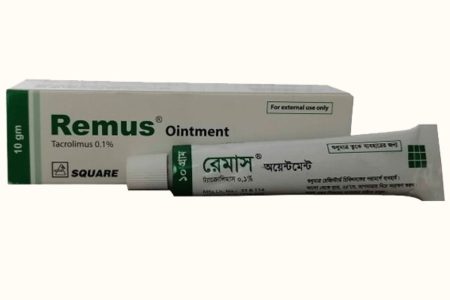
Type:10gm tube
Generic Name:Tacrolimus 0.1%, 0.03% Topical
Manufacturer:Square Pharmaceuticals PLC.
Price:৳360.00
Atopic dermatitis, Allergic contact dermatitis, Severe eczema, Psoriasis, Alopecia areata, Pyoderma gangrenosum, Cutaneous lupus erythematosus, Dermatomyositis, Seborrheic dermatitis, Rosacea, Lichen Planus, Pemphigus Vulgaris, Vitiligo, Graft-Versus-Host Disease, Ichthyosis.
Apply a thin layer of Tacrolim ointment onto the affected skin areas and rub in gently and completely. Treatment should be continued for one week after clearing of signs and symptoms of atopic dermatitis. Tacrolim ointment should not be used with occlusive dressings.
Topical/Cutaneous Atopic dermatitis Adult: Apply thinly 0.03% or 0.1% ointment to affected area bid. Rub in gently and completely. For short-term and intermittent use only. If no improvement after 6 wk, re-confirm diagnosis.
Topical/Cutaneous Atopic dermatitis <2 years old: Not recommended Child: 2-15 yr: Apply thinly 0.03% oint to affected area bid. Rub in gently and completely. For short-term and intermittent use only. >15 years: Apply 0.03% or 0.1% ointment as thin layer to affected area q12hr;
Tacrolimus ointment is contraindicated in patients with a history of hypersensitivity to Tacrolimus or any other component of the preparation.
Tacrolimus inhibits T-lymphocyte activation, although the exact mechanism of action unclear. Tacrolimus bind to cytosolic receptors known as immunophilins (i.e., cyclophilin and FK binding protein-12 [FKBP-12], respectively), forming complexes that inhibit the production of cytokines via the calcineurin pathway. Inhibition of calcineurin activity inhibits early activation of T-cells (ie.immunosuppresion results).
Monitoring of blood trough serum concentrations to prevent organ rejection and to reduce drug-related toxicity. Topical: Used with caution on the face or neck, large areas of the body (not >50% of the total BSA), or areas of broken skin. Infections at the treatment site should be cleared prior to therapy. Delay use in patients with unknown cause of lymphadenopathy or acute infectious mononucleosis till resolution. Use in patients with Netherton's syndrome is not recommended. Pregnancy. Lactation: Not known whether tacrolimus is distributed in milk following topical administration to skin
>10% Burning sensation (43-58%), Pruritus (41-46%), Flu-like symptoms (23-31%), Skin erythema (12-28%), Headache (5-20%)
Increased nephrotoxicity with ciclosporin, aminoglycosides, amphotericin B, cisplatin, NSAIDs, vancomycin, co-trimoxazole, aciclovir, ganciclovir. Increased risk of hyperkalemia with potassium-sparing diuretics. Increased plasma concentrations and toxicity with azole antifungals, calcium-channel blockers, cimetidine, danazol, HIV-protease inhibitors, macrolide antibacterials and metoclopramide. Antacids, rifampin, rifabutin, casofungin, phenytoin, phenobarbital and carbamazepine decrease tacrolimus plasma concentrations. Concurrent admin of sirolimus and tacrolimus decrease levels of both.